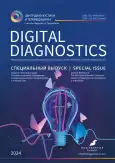Epidemiological analysis of pulmonary artery dilation prevalence in Moscow: automated computed tomography image analysis
- Authors: Solovev A.V.1,2, Sinitsyn V.E.1,3,4, Sokolova M.V.1, Kudryavtsev N.D.1, Vladzymyrskyy A.A.1, Semenov D.S.1
-
Affiliations:
- Research and Practical Clinical Center for Diagnostics and Telemedicine Technologies
- Morozov Children's Municipal Clinical Hospital
- City Clinical Hospital named after I.V. Davydovsky
- Lomonosov Moscow State University
- Issue: Vol 5, No 1S (2024)
- Pages: 152-154
- Section: Articles by YOUNG SCIENTISTS
- Submitted: 16.02.2024
- Accepted: 05.03.2024
- Published: 03.07.2024
- URL: https://jdigitaldiagnostics.com/DD/article/view/627074
- DOI: https://doi.org/10.17816/DD627074
- ID: 627074
Cite item
Full Text
Abstract
BACKGROUND: The state of health of the pulmonary system and its impact on the overall well-being of the individual is an important aspect of modern medicine. Despite continuous progress in diagnostics and technology, epidemiologic data on pulmonary trunk health at the population level in Russia remain understudied. In the context of this problem, the present study is an in-depth population-based analysis of the status of pulmonary trunk dilatation using modern technology and artificial intelligence [1].
Pulmonary trunk dilatation (≥29 mm) may be associated with various pathologies including arterial hypertension, chronic obstructive pulmonary disease, heart failure, and other diseases of the circulatory system [2].
AIM: The aim of the study was to assess the prevalence of pulmonary trunk dilatation in the Moscow population using artificial intelligence technologies.
MATERIALS AND METHODS: The study was conducted between September 2022 and February 2023 in the population of Moscow. A large amount of chest CT data was analyzed, including information on 134,218 patients (61,514 men and 72,704 women). Artificial intelligence technologies were used to automatically process this data.
RESULTS: The results show that 49,227 (36.7%) patients — 23,720 (38.6%) men and 25,507 (35.1%) women — had evidence of pulmonary trunk dilatation. The analysis shows gender and age differences in the incidence of the pathology. The distribution of pulmonary trunk dilatation in the population shows age dependence. The percentage of patients with signs of pulmonary trunk dilatation increases with age: from 18.1% in the group of young people to 62.2% in the group of elderly people.
CONCLUSIONS: The study provides the first epidemiological data on pulmonary trunk dilatation in Moscow and emphasizes the importance of further research in this area. The findings may serve as a basis for the development of effective diagnostic and treatment strategies, as well as for further research in the field of artificial intelligence in medicine.
Full Text
BACKGROUND: The state of health of the pulmonary system and its impact on the overall well-being of the individual is an important aspect of modern medicine. Despite continuous progress in diagnostics and technology, epidemiologic data on pulmonary trunk health at the population level in Russia remain understudied. In the context of this problem, the present study is an in-depth population-based analysis of the status of pulmonary trunk dilatation using modern technology and artificial intelligence [1].
Pulmonary trunk dilatation (≥29 mm) may be associated with various pathologies including arterial hypertension, chronic obstructive pulmonary disease, heart failure, and other diseases of the circulatory system [2].
AIM: The aim of the study was to assess the prevalence of pulmonary trunk dilatation in the Moscow population using artificial intelligence technologies.
MATERIALS AND METHODS: The study was conducted between September 2022 and February 2023 in the population of Moscow. A large amount of chest CT data was analyzed, including information on 134,218 patients (61,514 men and 72,704 women). Artificial intelligence technologies were used to automatically process this data.
RESULTS: The results show that 49,227 (36.7%) patients — 23,720 (38.6%) men and 25,507 (35.1%) women — had evidence of pulmonary trunk dilatation. The analysis shows gender and age differences in the incidence of the pathology. The distribution of pulmonary trunk dilatation in the population shows age dependence. The percentage of patients with signs of pulmonary trunk dilatation increases with age: from 18.1% in the group of young people to 62.2% in the group of elderly people.
CONCLUSIONS: The study provides the first epidemiological data on pulmonary trunk dilatation in Moscow and emphasizes the importance of further research in this area. The findings may serve as a basis for the development of effective diagnostic and treatment strategies, as well as for further research in the field of artificial intelligence in medicine.
About the authors
Alexander V. Solovev
Research and Practical Clinical Center for Diagnostics and Telemedicine Technologies; Morozov Children's Municipal Clinical Hospital
Author for correspondence.
Email: atlantis.92@mail.ru
ORCID iD: 0000-0003-4485-2638
SPIN-code: 9654-4005
Врач-рентгенолог, врач-радиолог, младший научный сотрудник отдела инновационных технологий.
Russian Federation, Moscow; MoscowValentin E. Sinitsyn
Research and Practical Clinical Center for Diagnostics and Telemedicine Technologies; City Clinical Hospital named after I.V. Davydovsky; Lomonosov Moscow State University
Email: vsini@mail.ru
ORCID iD: 0000-0002-5649-2193
SPIN-code: 8449-6590
Russian Federation, Moscow; Moscow; Moscow
Maria V. Sokolova
Research and Practical Clinical Center for Diagnostics and Telemedicine Technologies
Email: SokolovaMV10@zdrav.mos.ru
ORCID iD: 0009-0005-3689-3810
Russian Federation, Moscow
Nikita D. Kudryavtsev
Research and Practical Clinical Center for Diagnostics and Telemedicine Technologies
Email: KudryavtsevND@zdrav.mos.ru
ORCID iD: 0000-0003-4203-0630
SPIN-code: 1125-8637
Russian Federation, Moscow
Anton A. Vladzymyrskyy
Research and Practical Clinical Center for Diagnostics and Telemedicine Technologies
Email: VladzimirskijAV@zdrav.mos.ru
ORCID iD: 0000-0002-2990-7736
SPIN-code: 3602-7120
Russian Federation, Moscow
Dmitry S. Semenov
Research and Practical Clinical Center for Diagnostics and Telemedicine Technologies
Email: SemenovDS4@zdrav.mos.ru
ORCID iD: 0000-0002-4293-2514
SPIN-code: 2278-7290
Russian Federation, Moscow
References
- Vasil'ev YuA, Vladzimirskii AV, editors. Computer Vision in Radiologic Diagnostics: the First Stage of the Moscow Experiment. Moscow: Izdatel'skie resheniya; 2023. (In Russ).
- Galiè N, Humbert M, Vachiery JL, et al. 2015 ESC/ERS Guidelines for the diagnosis and treatment of pulmonary hypertension: The Joint Task Force for the Diagnosis and Treatment of Pulmonary Hypertension of the European Society of Cardiology (ESC) and the European Respiratory Society (ERS): Endorsed by: Association for European Paediatric and Congenital Cardiology (AEPC), International Society for Heart and Lung Transplantation (ISHLT). Eur. Resp J. 2015;46:903–975. doi: 10.1183/13993003.01032-2015
Supplementary files















